Choosing the Right Water
The choice of water is essential for obtaining high-quality coffee and, above all, for preserving the life of your espresso machine.
Using improper water can cause permanent damage to the boiler and internal pipes and compromise the machine's proper functioning over time.
Let's take a look at which types of water are recommended and which should be strictly avoided.
Remember that any damage caused by limescale formation due to the use of unsuitable water is not covered by the warranty.
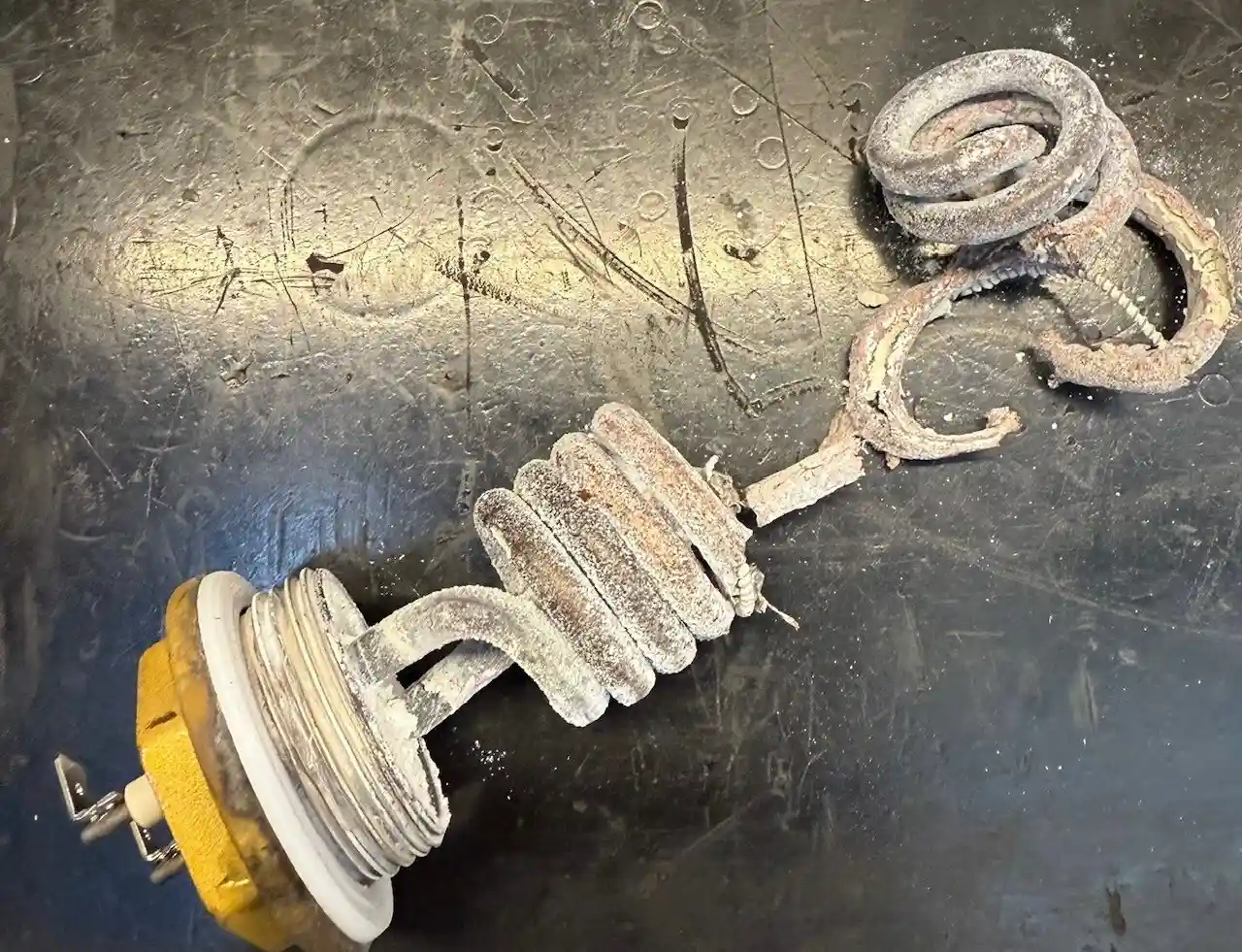
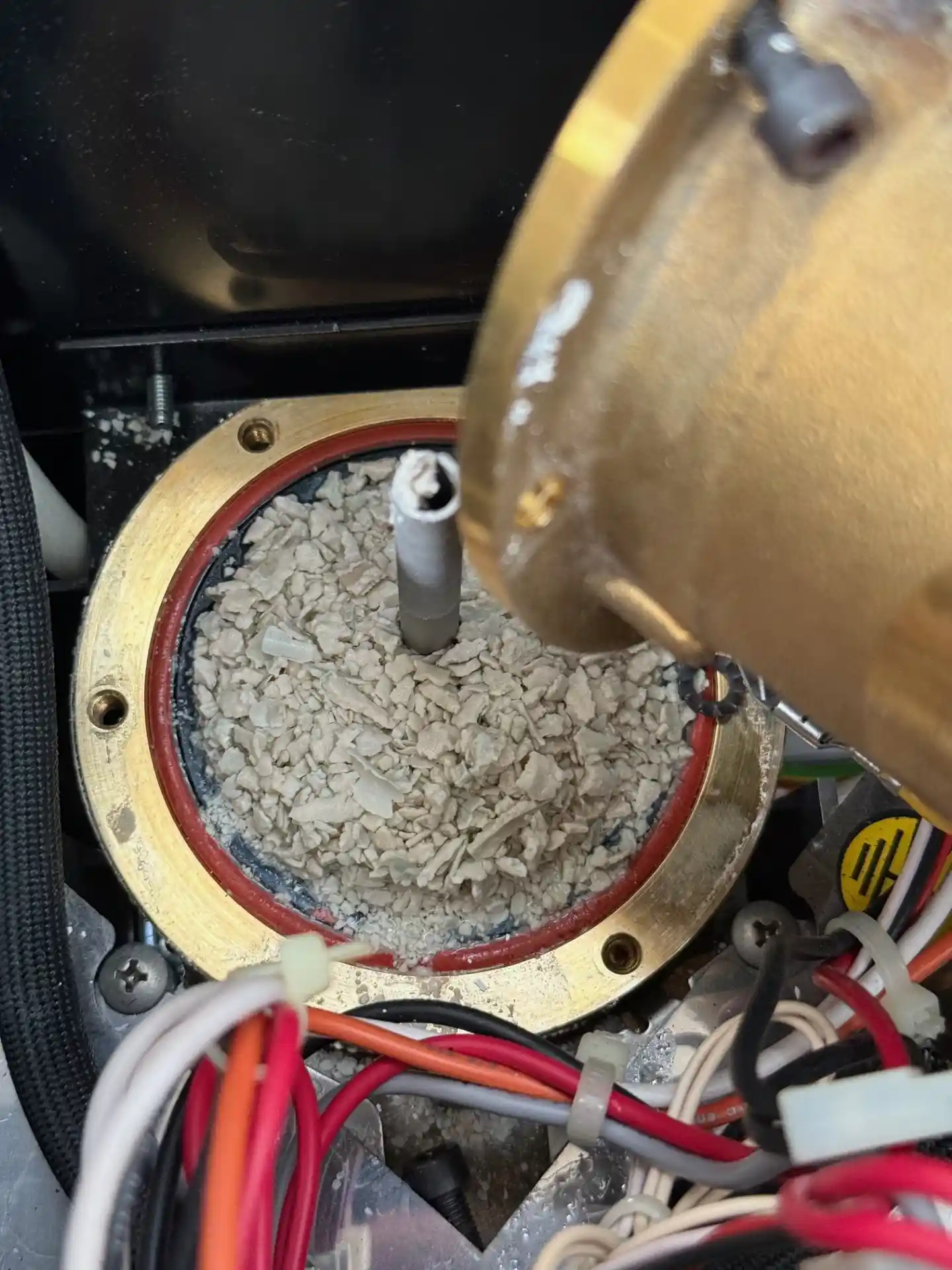
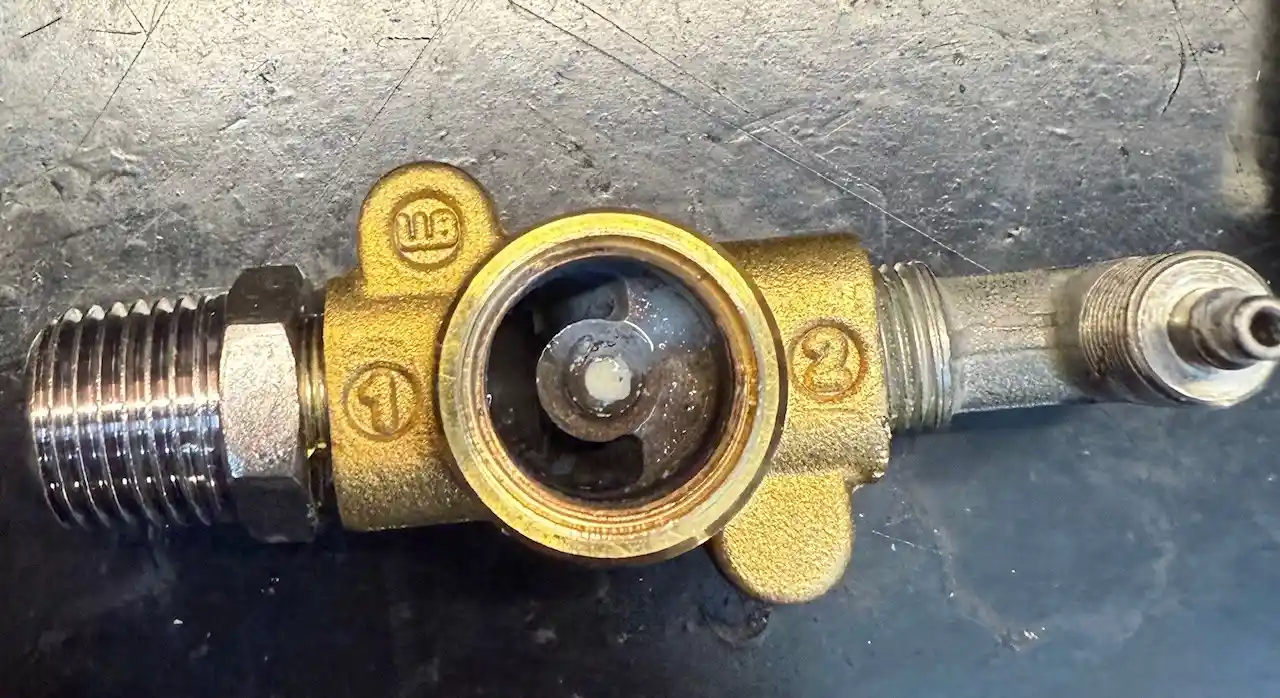
However, with proper filtration, descaling, and regular cleaning, your machine will continue to perform well for many years, requiring minimal maintenance.
Tap Water: Beware of Hardness
In most parts of the world, 80-90% of tap water is considered hard, meaning it is rich in calcium and magnesium salts.
To make a good coffee without damaging the machine, the water must have a balanced mineral content. If minerals are present in excess, they tend to build up inside the machine, leading to limescale deposits that can compromise its efficiency and proper functioning.
The mineral content of water is measured by the TDS (Total Dissolved Solids) parameter.
The ideal water for espresso extraction should have a TDS between 90 and 150 ppm — the range that provides the right amount of minerals to extract the coffee’s oils and aromas without damaging the machine.
Below is a reference table shared by La Marzocco with all the parameters to keep in mind when choosing water for your coffee.
| Value | Units | Minimum | Maximum |
|---|---|---|---|
| T.D.S. | ppm | 90 | 150 |
| Total Hardness | ppm | 70 | 100 |
| Total Iron | ppm | 0.0 | 0.02 |
| Free Chlorine | ppm | 0.0 | 0.05 |
| Total Chlorine | ppm | 0.0 | 0.1 |
| pH | 6.5 | 8 | |
| Alkalinity | ppm | 40 | 80 |
| Chloride | ppm | 0 | 30 |
If you choose to use tap water for your espresso machine, it is essential to always check its characteristics and compare them with the recommended parameters. You can request detailed information from your local water utility provider, or analyze it yourself using specific measurement tools.
We recommend the BWT Kit, a simple and practical tool that allows you to measure both the carbonate and total hardness of the water.
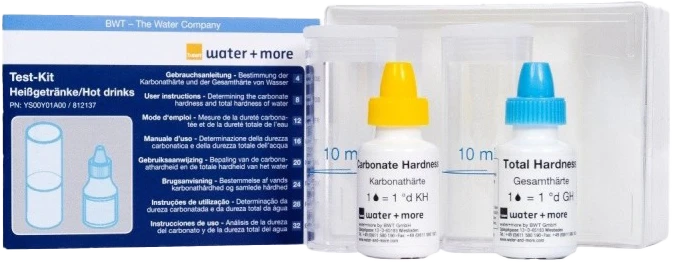
Based on the values measured, it will then be essential to intervene with the right treatment systems to reduce the limescale content and optimize water quality, thus protecting the machine and improving coffee extraction.
Tap Water Directly Into the Tank
If you use tap water to fill the tank, we recommend inserting the BWT BestSave M anti-scale tablet.
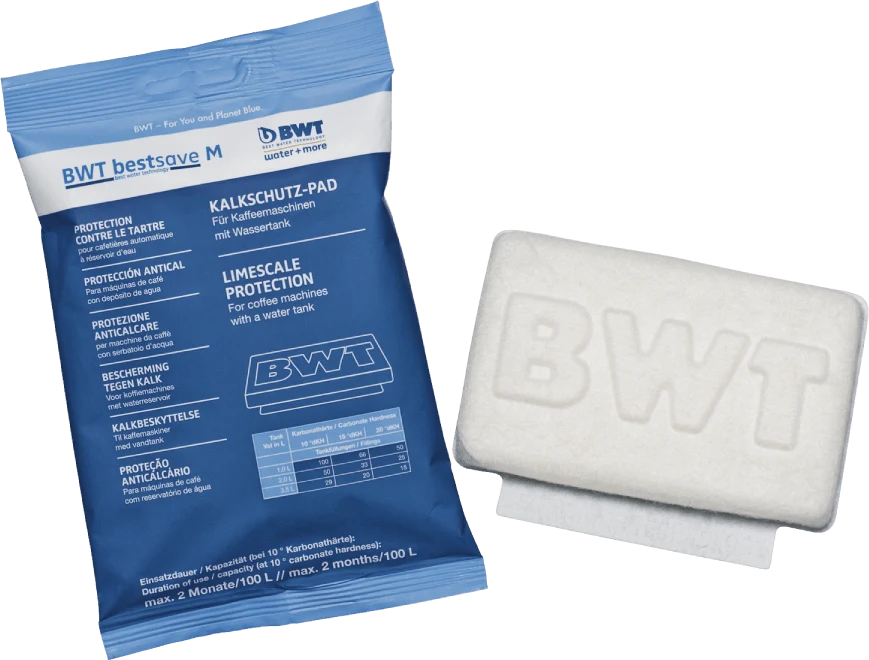
This practical device effectively prevents limescale buildup by inhibiting the accumulation of calcium carbonate inside the machine.
After opening the package, rinse the sachet under running water and place it at the bottom of the tank. The ion exchanger takes about 10 hours to work effectively, so we recommend filling the tank in the evening and leaving the BestSave sachet inside. This way, you will have treated water ready for use the next day.
The table below helps you calculate the maximum filtering capacity of the BWT bag. Match the hardness of your water with the size of the tank and you can then read the number of fillings. In any case, the bag should never be left in the tank for more than two months.
| Water Hardness | Soft | Medium | Hard | |
| Carbonate Hardness | 10° KH | 15° KH | 20° KH | |
| Tank capacity (liters) | Refills/Days | |||
| BWT Bestsave M 100 liters* | 1.0 | 100 | 66 | 50 |
|---|---|---|---|---|
| 2.0 | 50 | 33 | 25 | |
| 3.0 | 29 | 20 | 15 | |
*Typical filtration capacity at 10° carbonate hardness
If you are using a Lelit espresso machine, you can also choose water softener filters from the same brand and insert them directly into the tank. They are sold in packs of two filters, each with a 70-liter capacity, and are compatible with all Lelit espresso machines.
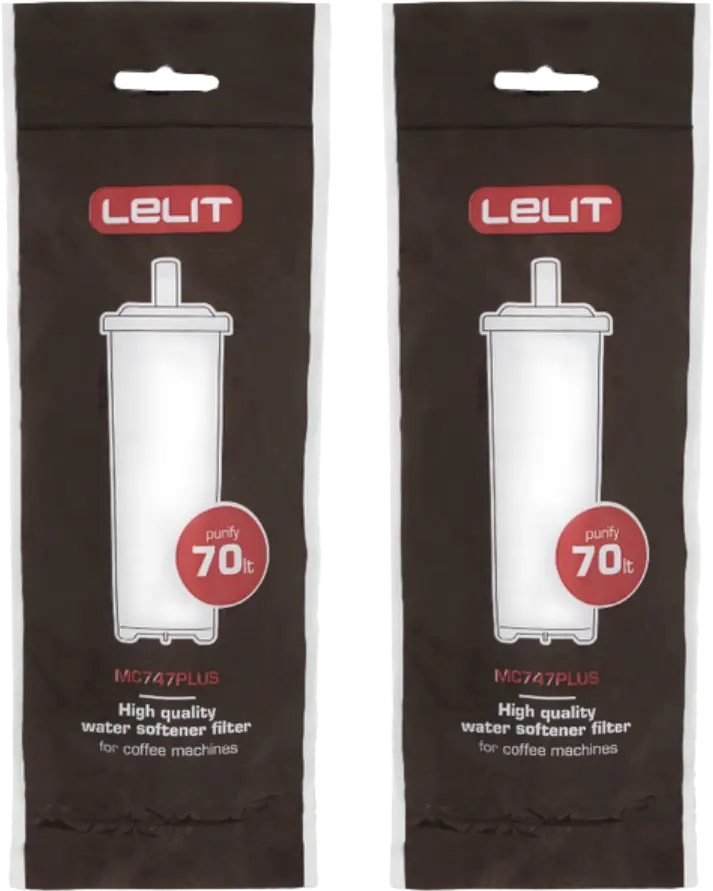
Alternatively, you can use the BWT Aqualizer filter jug to treat the water before pouring it into the machine's tank. Thanks to its advanced filtration system, BWT Aqualizer effectively reduces limescale, heavy metals, and other impurities, improving water quality and helping to preserve the performance of your espresso machine.
In general, a water filter jug is a good solution for treating water, but its filtering capacity is lower than the BWT BestSave M when used in espresso machines.

Direct Connection to the Water Supply System
If you decide to connect your espresso machine directly to the water supply, we recommend using Bestmax PREMIUM by BWT .
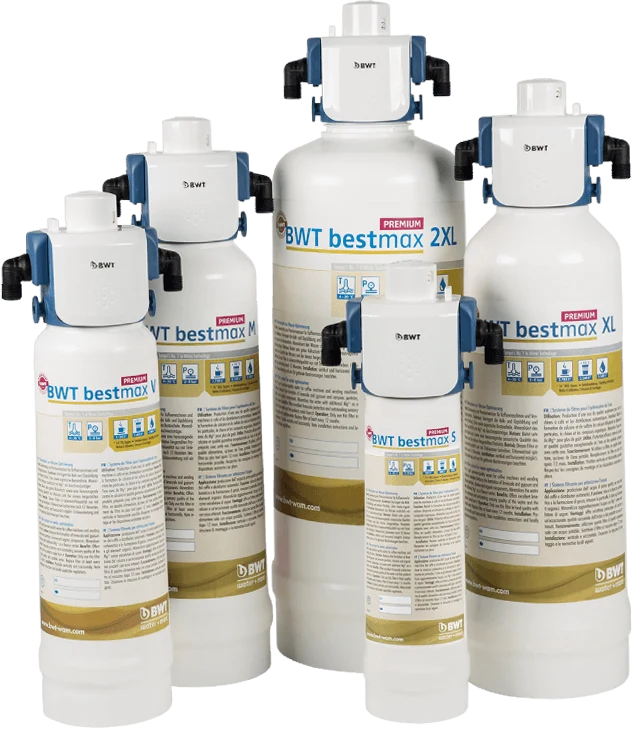
This filtration system removes substances that can compromise the proper functioning of the machine, such as limescale, chlorine, and heavy metals. In addition, thanks to the magnesium technology developed by BWT, part of the calcium present in the water is replaced with magnesium, helping to enhance the coffee's flavor in the cup.
Filter cartridges are available in different sizes, from the smallest (size S) to the largest (size XXL, ideal for bars and cafés), so you can choose the size that best suits your consumption needs.
This filtration system must be combined with BWT Besthead , a connection head that fits all filter cartridges.

Depending on the water hardness, you can adjust the bypass on the head by selecting a value from 1 to 3, thereby modifying the filter capacity and the cartridge's lifespan in liters.
Below is a BWT chart to help you choose the right setting based on the properties of your water.
°dTH = German total hardness. Subject to change.
| Total Hardness (°dTH) | Bypass | Size | ||||
|---|---|---|---|---|---|---|
| S | V | M | XL | 2XL | ||
| ≤ 7 °dTH | 3 | ≥ 1070 | ≥ 2570 | ≥ 3855 | ≥ 6140 | ≥ 10000 |
| 8 °dTH | 3 | 935 | 2250 | 3375 | 5375 | 8750 |
| 10 °dTH | 3 | 750 | 1800 | 2700 | 4300 | 7000 |
| 12 °dTH | 2 | 565 | 1360 | 2040 | 3250 | 5290 |
| 14 °dTH | 2 | 485 | 1165 | 1750 | 2785 | 4535 |
| 17 °dTH | 1 | 355 | 860 | 1290 | 2060 | 3355 |
| 20 °dTH | 1 | 305 | 730 | 1100 | 1750 | 2850 |
| 23 °dTH | 1 | 265 | 635 | 955 | 1520 | 2480 |
| ≥ 25°dTH | 1 | ≤ 240 | ≤ 585 | ≤ 880 | ≤ 1400 | ≤ 2280 |
The final step to properly complete the water filtration system is to install the BWT AQA Monitor water meter . This digital meter allows you to accurately monitor your filtered water consumption. It connects directly to the Besthead connection head and, thanks to the integrated LCD display, shows the remaining filter capacity in real time. This allows you to know exactly when to replace the Bestmax PREMIUM cartridge, ensuring optimal performance of the espresso machine and consistent quality in the cup.
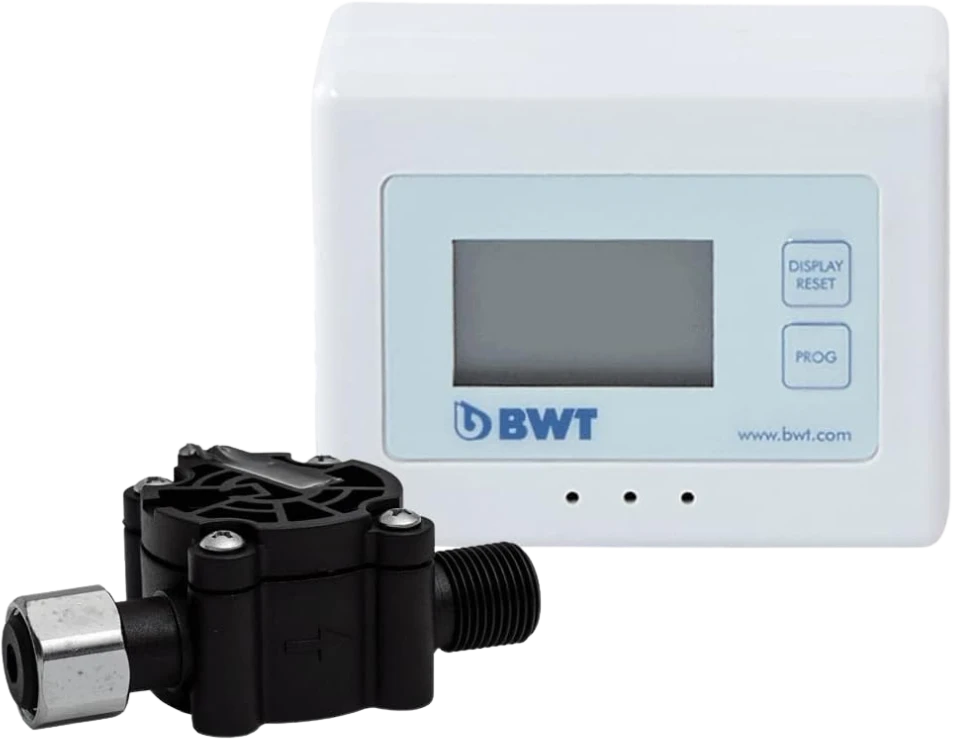
Bottled Water: Yes, but with Care
Using bottled water is a practical and immediate solution, ideal for getting started without the need to purchase additional accessories. However, it is not the most environmentally sustainable alternative.
However, it is essential to always check the label or test the water you have chosen to ensure that it complies with the ideal parameters indicated above. This is the only way to guarantee the correct mineral balance, which is essential both for obtaining a high-quality espresso and for preserving the health of the machine over time.
Among the most commonly recommended waters by professional machine manufacturers, such as La Marzocco, is Acqua Panna: a water with a balanced mineral profile, particularly suitable for espresso preparation.
Even if you use bottled water, you can consider adding the BWT BestSave M anti-scale tablet to the tank to provide extra protection against limescale build-up.
Distilled or Demineralized Water: NEVER
It may sound like a “pure” choice, but distilled water is highly discouraged for use in espresso machines and can cause more serious damage than hard water.
The total absence of minerals compromises the taste of the espresso, making it flat, unbalanced, and lacking in aromatic complexity.
In addition, many machines are unable to detect distilled water correctly: several models use the electrical conductivity of water—linked to its mineral content—to monitor the level in the tank. With completely demineralized water, the machine may report an empty tank.
Finally, prolonged use of distilled water can promote corrosion of some internal components, particularly in machines equipped with boilers or metal pipes.
Long-term unuse of the machine
In case of prolonged inactivity, starting from one week, it is advisable to empty both the tank and the boiler of the machine. This prevents water stagnation, reduces the risk of bacterial proliferation, and prevents the formation of limescale deposits, helping to keep the hydraulic system clean and efficient over time.
Cleaning
Keeping your equipment clean is not just a hygiene issue, but a key factor in ensuring that the machine continues to work properly over time and guarantees a clean, balanced espresso.
Coffee residues and oils can build up, causing blockages that compromise extraction, flow, and pressure during preparation.
On our website, you will find a wide selection of PulyCaff products, which we confidently recommend to our customers for effective and professional cleaning.
Soak Cleaning System
Soak Cleaning System is the perfect and most complete solution for quickly cleaning filter holders, shower heads, filters, and other metal components.
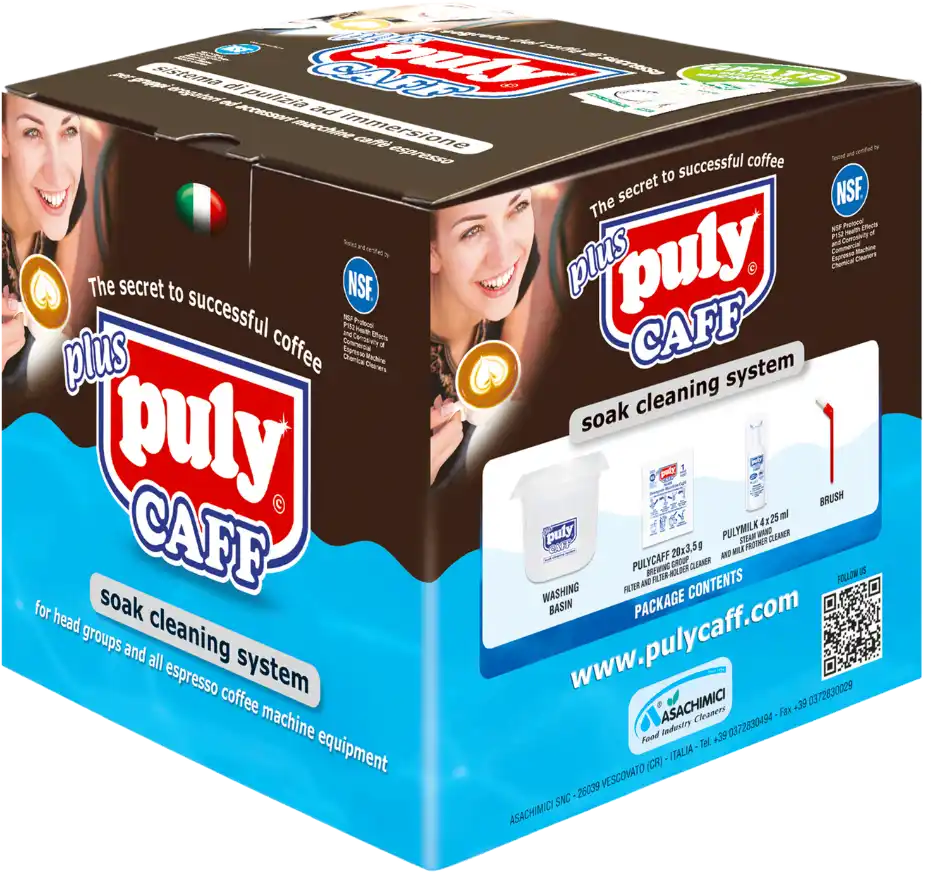
The kit includes a washing basin, 20x 3.5-gram sachets of pulyCAFF, 4x 25-mL bottles of PulyMILK, 1x brush, and 2x sachets of pulyGRIND (a very convenient bonus for trying out the coffee grinder cleaning products we will see in a moment).
Simply dip the pieces in the bowl with hot water, add the specific cleaner and leave it to work. We recommend using very hot water for the stubborn dirt to melt away. Once finished, be sure to rinse everything thoroughly with plenty of water.
Cleaning the group unit
To clean the group, you can purchase pulyCAFF Plus cleaner in various sizes, 370 g or 900 g, or the pulyCAFF Plus Tabs version.
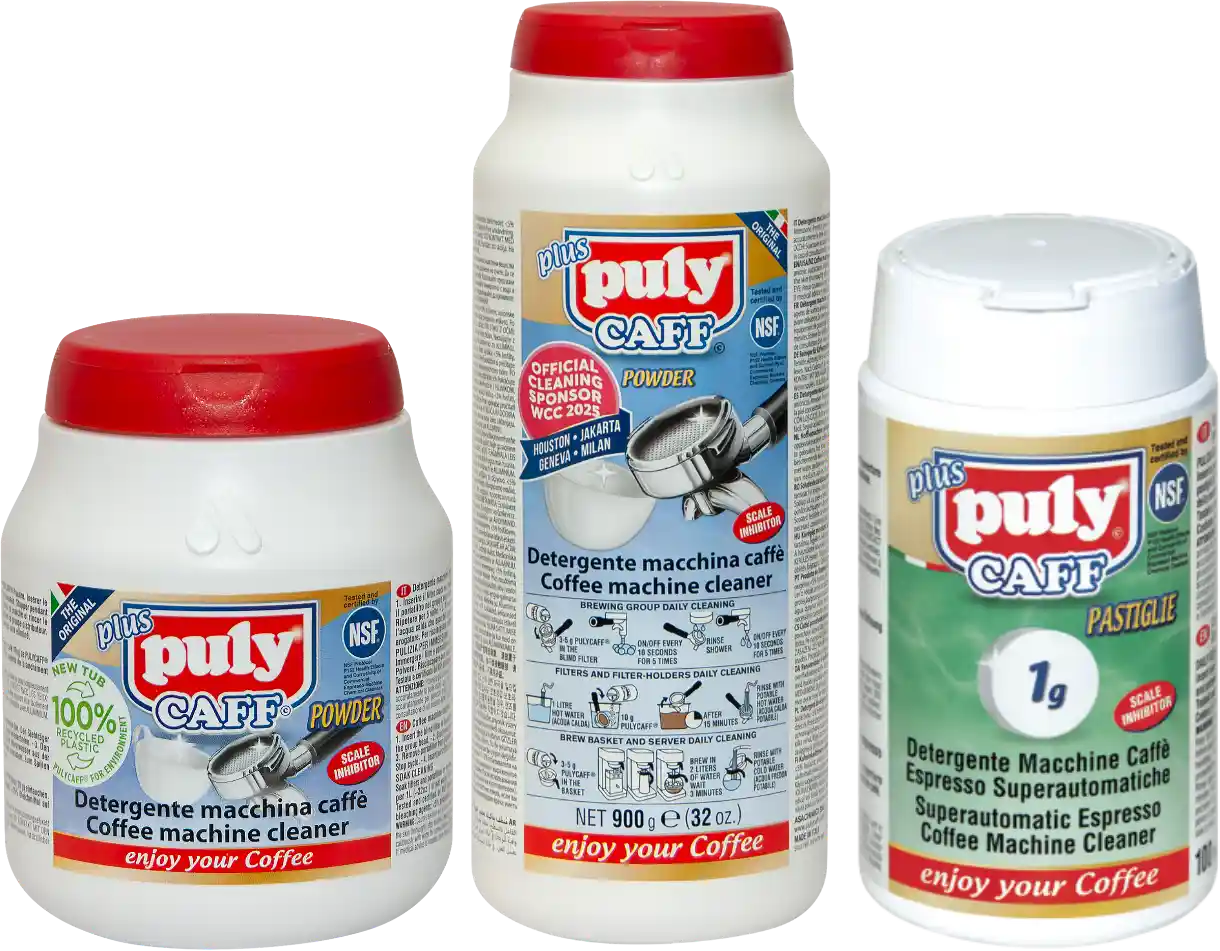
Besides soaking the parts in a tray like with the Soak Cleaning System, you can also use pulyCAFF Plus to make backflushes with the blind filter and clean everything in depth.
Here are the steps to follow:
- Pour approximately 5 grams of pulyCAFF PLUS or a tablet into the blind filter
- Start the brew cycle for 10 seconds and stop it for 10 seconds, repeat 10 times
- Unhook the filter holder and rinse the filter with water
- To rinse the unit, insert the portafilter with the clean blind filter and start brewing for 10 seconds then stop it for 10 seconds, repeat 10 times
We recommend cleaning the unit regularly, about once a week. This will remove all coffee residues and oils that affect the taste and compromise the machine's performance.
pulyMILK Plus
Cappuccino lovers know how easily milk residue can build up inside the steam wand and milk jugs. The pulyMILK Plus is specifically formulated to remove milk-derived fats, sugars and proteins, ensuring hygiene and perfect steam wand working.
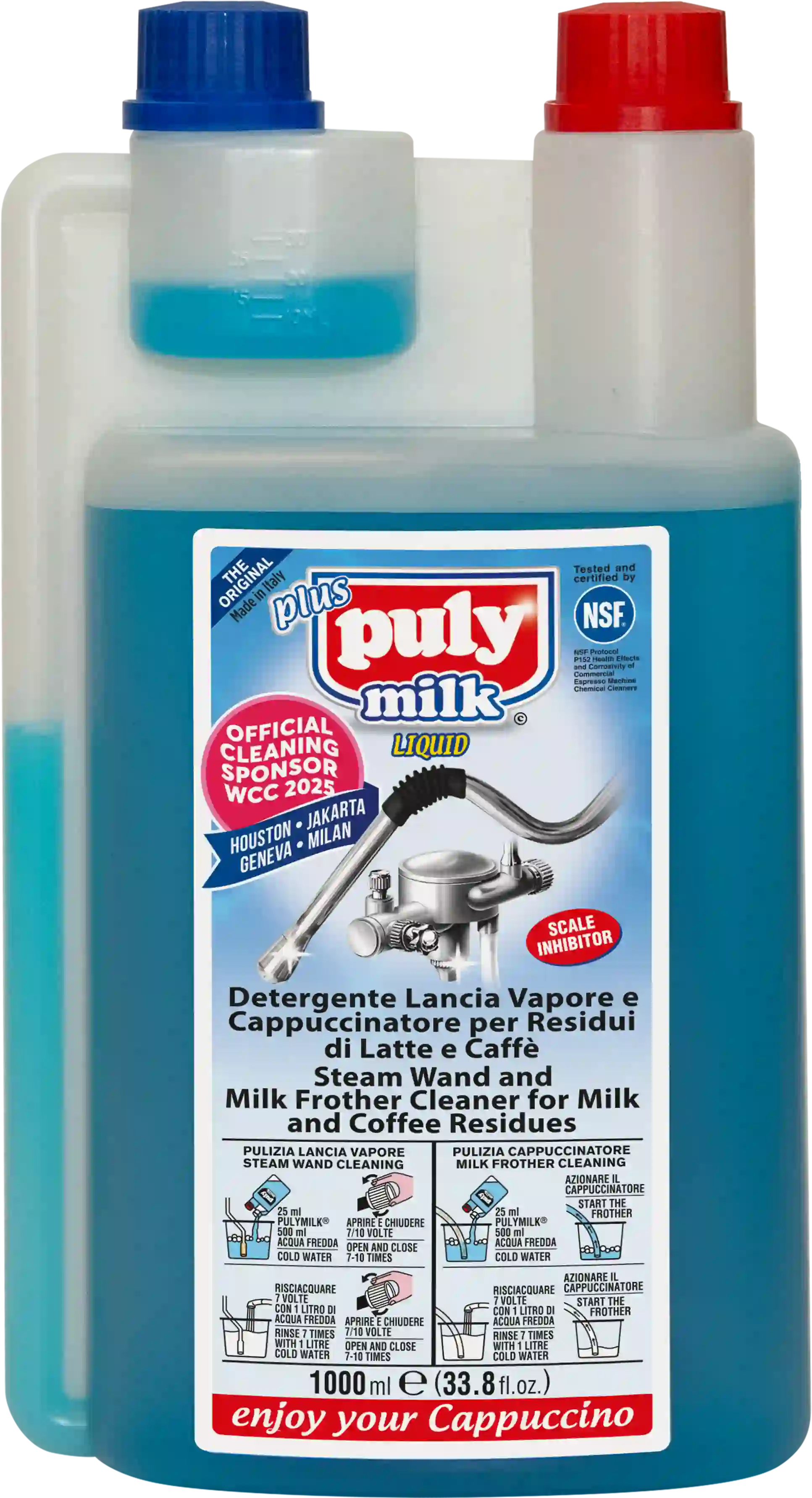
To prevent unpleasant odors and malfunctions, it is important to use pulyMILK Plus after intensive use of the wand or, if it has not been cleaned, immediately after frothing milk.
How to clean the steam wand:
- Immerse the steam wand in a basin with 500 ml of cold water and 25 ml of pulyMILK Plus
- Open the steam wand for 1 second and close for 10 seconds. Repeat for 7-10 times
- To rinse, immerse the steam wand in a basin with 1 liter of cold water, open the wand for 1 second and close. Repeat for 7-10 times
Haven’t Performed Regular Cleaning or Used the Right Water? That’s Bad! But there’s still hope!
Your last hope is called Puly Cleaner, a powerful descaler to be used ONLY IN EMERGENCY CASES!
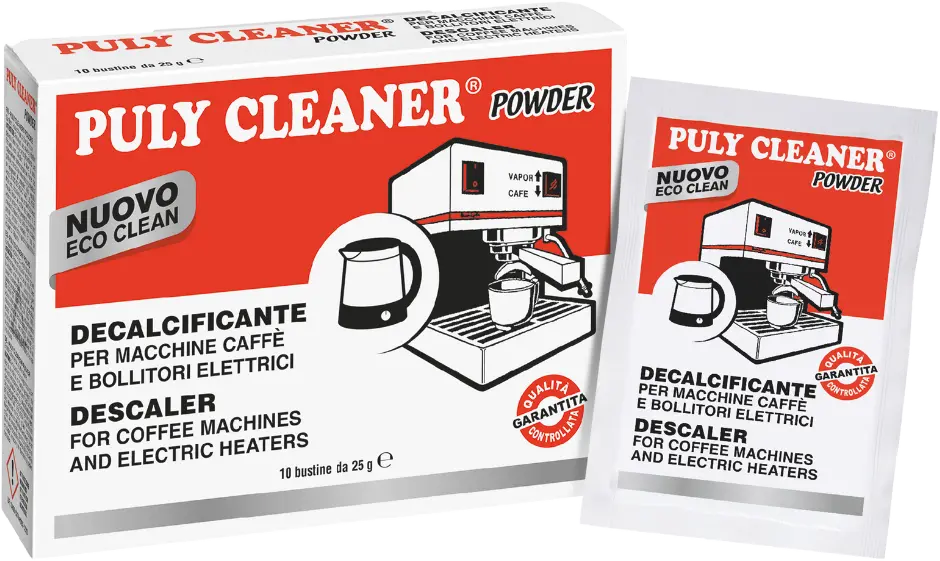
Here are all the steps to follow:
- After using the machine, turn it off and empty the water left in the boiler
- Dissolve one sachet of Puly Cleaner in one liter of water and pour it inside the tank
- Turn on the machine, wait for it to reach the right temperature and pressure, and brew a couple of times to allow the water with the descaling agent to get into the system
- Leave for about 30 minutes and then turn off the machine
- Drain all the water containing the descaler. You may notice a blue or green tint in the water—this is completely normal and simply the result of Puly Cleaner reacting with the internal components of the machine
- Now, to clean the machine's interior from the descaler, you need to repeat 4/5 times filling the tank with clean water and emptying the machine until the water comes out completely clear
It’s a time-consuming process that can take several hours, and we do not recommend performing it unless absolutely necessary, only in extreme cases when the machine is no longer functioning properly. Although useful for resolving critical situations, descaling also involves certain risks: it can break off pieces of limescale which, once released into the system, could cause damage to the machine.
It is therefore very important not to reach this point by using water filtration products and cleaning regularly.
Taking care of your espresso machine by choosing the right water and following a proper cleaning and maintenance routine is not just a gesture of care: it is the best way to preserve its performance over time and always obtain a high-quality coffee, rich in aroma and with a balanced taste.
With a few simple steps and the right tools, you can enjoy a perfect espresso every day while protecting your investment in your equipment.
If you have any questions or concerns, we are here to help: you can write to us at support@espressocoffeeshopusa.com or call us at (786) 305-4932.
Enjoy your coffee!










